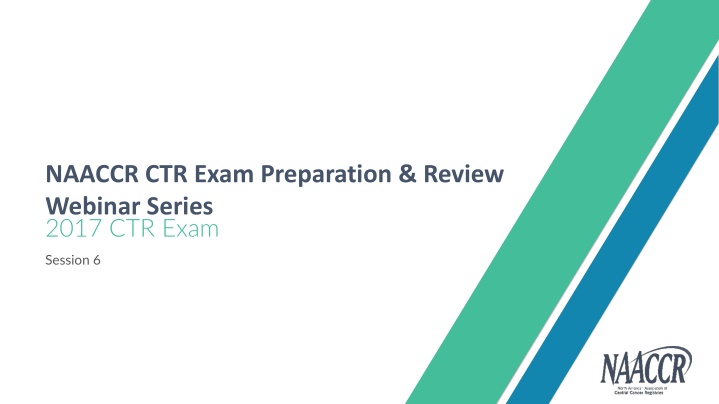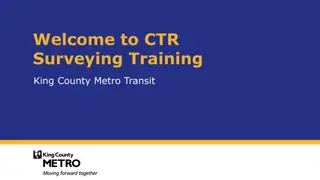NAACCR CTR Exam Preparation & Review Webinar Series - Analysis, Data Usage, Resources
This content discusses various aspects of the NAACCR CTR exam preparation, including analysis, data usage, and important resources such as Cancer Registry Management Principles & Practice. It delves into clinical research topics like clinical trials, cooperative oncology groups, and the phases of clinical trials, providing valuable insights for individuals preparing for the exam or interested in the field.
Download Presentation

Please find below an Image/Link to download the presentation.
The content on the website is provided AS IS for your information and personal use only. It may not be sold, licensed, or shared on other websites without obtaining consent from the author.If you encounter any issues during the download, it is possible that the publisher has removed the file from their server.
You are allowed to download the files provided on this website for personal or commercial use, subject to the condition that they are used lawfully. All files are the property of their respective owners.
The content on the website is provided AS IS for your information and personal use only. It may not be sold, licensed, or shared on other websites without obtaining consent from the author.
E N D
Presentation Transcript
NAACCR CTR Exam Preparation & Review Webinar Series 2017 CTR Exam Session 6
Analysis & Data Usage 27 Questions
Resources Cancer Registry Management Principles & Practice, 3rd Edition Chapters 22, 24, 25, 40 AJCC Cancer Staging Manual, 7th Ed. Chapter 2 Cancer Survival Analysis SEER Self Instructional Manual Book 7: Statistics and Epidemiology for Cancer Registrars 3
Clinical Research Clinical trials Medical research studies designed to answer questions about new drugs or devices Cooperative oncology groups Investigators from several institutions that design and implement clinical trials Intergroup Two or more clinical trial groups join so that a larger number of patients from a wider geographic area can participate 4
Clinical Research Clinical trial protocol Parameters for the clinical trial Principal investigator Person in charge of the clinical trial 5
Clinical Research Institutional Review Board (IRB) Approves any clinical trial and/or research using human subjects in the healthcare setting IRB purposes Protect rights and welfare of clinical research participants Guarantee informed consent Articulate risks and benefits of the experiment 6
Clinical Research Clinical trial phases Phase III Compare prevention or treatment with the standard treatment Control group (arm) Investigational group (arm) Phase IV Obtain additional information about product being tested 7
Clinical Research Clinical trial phases Phase I Test the toxicity of the prevention or treatment and determine tolerable dosage levels Phase II Determine safety and efficacy of the prevention or treatment 8
Clinical Research Randomization Assigning participants to groups (arms) in clinical trials Assignment is by chance Prevents research bias 9
Clinical Research Single Blinding Subject does not know which group they are in Double Blinding Subject and investigator do not know which group they are in Triple Blinding Subject, investigator, and the analyzer do not know which group the subject is in 10
Clinical Research Informed consent Describes the study and procedures in non technical language Must be written in a language participant understands Voluntary Subject must be mentally competent to understand information Two acceptable methods Printed form Oral presentation Witness must be present 11
Pop Quiz The explanation of the purpose of a clinical trial including how the study will be performed and why it is necessary is: a. Informed consent b. Institutional review board c. Protocol d. Randomization 12
Pop Quiz When patients are assigned to clinical trial arms, what prevents selection bias? a. Informed consent b. Institutional review board c. Protocol d. Randomization 13
Statistics Concepts & Terminology Statistics Are mathematical methods used to summarize data Are used to produce data summaries presented in tables and graphs Make a representation about a population 14
Statistics Concepts & Terminology Population Set of measurements of interest to the researcher Example: Females with breast cancer living in Georgia in 2014 Sample Subset of the population Example: 10% of females with breast cancer living in Georgia in 2014 15
Statistics Concepts & Terminology Calculating rates Numerator The number of people to whom something happened (i.e. they got sick, died, diagnosed with cancer, etc.) Denominator The population at risk for the event 16
Statistics Concepts & Terminology Prevalence Measure of proportion of population affected with a disease at a specific time Prevalence rate ??? ????? ?? ? ? ??????? ?? ?????????? ?????? ?? ???? ?? ?????????? ?????? ???? ???? ?????? 17
Statistics Concepts & Terminology Incidence Number of new cases of a specific disease in a specified population during a specific time period Incidence rate ??? ????? ?? ? ? ??????? ?? ?????????? ?????? ?? ???? ?? ?????????? ?????? ???? ???? ?????? 18
Statistics Concepts & Terminology Mortality Number of fatalities due to a specific cause in a specific population during a specific time period Mortality rate ?????????? ??? ?? ???????? ????? ?? ?????????? ??????? ?? ???? ?? ?????????? ?????? ???? ???? ?????? 19
Statistics Concepts & Terminology Calculating rates Crude rates Specific rates Age-adjusted rates Standard population 20
Pop Quiz The 2014 population of Busytown USA is 100,000 people including 48,000 females and 52,000 males. During 2014 240 women had ovarian cancer with 100 of those being newly diagnosed in 2014. There were 20 women who died of ovarian cancer in 2014 in Busytown. 21
Pop Quiz How would you calculate the 2014 incidence rate of ovarian cancer in Busytown? a. 100/100,000 b. 100/48,000 c. 240/48,000 d. 240/100,000 In the formula to calculate the incidence rate of ovarian cancer in Busytown in 2014, 100 is the: a. Denominator b. Numerator c. Population d. Sample 22
Statistics Concepts & Terminology Descriptive statistics Enumerate, organize, and graphically represent data Inferential statistics Make conclusions about a population using information from a specific sample 23
Statistics Concepts & Terminology Data sources for statistics Cancer registries (surveillance systems) Planned surveys (government, universities) Experiments (pharmaceutical companies) Health organizations (administrative data sets) Private sector (banks, companies, etc.) Government (all government agencies) 24
Statistical Techniques Measures of central tendency ??? ?? ??? ?????? ????? ?????? ?? ?????? Average of group of values Median Middle of a group of values Mode Value that occurs most often in a group Mean = 25
Statistical Techniques Measures of dispersion Range Minimum and maximum values from continuous data Difference between the upper and lower limits of a series of values Variance Average of the squared differences from the mean Standard deviation Square root of the variance 26
Pop Quiz Ages of lung cancer patients 45, 55, 66, 66, 73 What is the mean of the ages of this group of lung cancer patients? a. 28 b. 61 c. 66 d. 305 28
Pop Quiz Ages of lung cancer patients 45, 55, 66, 66, 73 What is the median of the ages of this group of lung cancer patients? a. 28 b. 61 c. 66 d. 305 29
Pop Quiz Ages of lung cancer patients 45, 55, 66, 66, 73 What is the mode of the ages of this group of lung cancer patients? a. 28 b. 61 c. 66 d. 305 30
Pop Quiz Ages of lung cancer patients 45, 55, 66, 66, 73 What is the range of the ages of this group of lung cancer patients? a. 28 b. 61 c. 66 d. 305 31
Pop Quiz The graph to the right is an example of what kind of curve? a. Right skewed curve b. Normal curve c. Left skewed curve d. None of the above 32
Types of Data Categorical or qualitative data variables Nominal Example: Race, sex, marital status Ordinal Example: Stage of disease 33
Types of Data Continuous or quantitative data variables Interval Example: Survival Ratio Example: Tumor size 34
Statistical Testing Qualitative (Categorical) Chi square Used to predict if variance is due to chance or some other factor Logistic regression Used to predict probability of a nominal value 35
Statistical Testing Quantitative (Continuous) Correlation Coefficient Measures the extent to which two variable are associated T-test Used to calculate whether there is a statistically significant difference between mean values for quantitative data P-value Probability that the difference between the two means in the t-test are similar Regression Analysis Relationship between a dependent variable and one or more independent variables 36
Study Design Retrospective studies Use past data Case-control studies Cancer cluster studies Patterns of care studies Prospective studies Use current data Cohort studies 37
Pop quiz The age of the female population in a specific geographic area diagnosed with breast cancer in 2010 was presented as younger than 50, 51-60, 61-70, 71-80, and 81 and older. In this presentation, what kind of variable is age? a. Interval b. Nominal c. Ordinal d. Ratio 38
Pop Quiz Dietary and lifestyle characteristics were evaluated in relation to subsequent prostatic cancer risk in a cohort of approximately 14,000 Seventh-day Adventist men who completed a detailed lifestyle questionnaire in 1976 and who were monitored for cancer incidence until the end of 1982. What type of study was this? a. Case-control b. Mortality c. Prospective d. Retrospective 39
Epidemiology Epidemiology Study of the determinants, distribution, and frequency of disease in human populations Purpose of epidemiology To provide a basis for developing disease control and prevention measures for groups at risk 40
Sequence of Epidemiologic Reasoning 1. Observe a non-random pattern 2. Develop a hypothesis 3. Test the hypothesis 41
Observe Patterns Epidemiologists use rates to observe patterns Incidence rates Prevalence rates Mortality rates Survival rates 42
Develop Hypothesis Null Hypothesis (H0) No meaningful difference between groups Alternative Hypothesis (Ha) Meaningful difference between groups 43
Test Hypothesis Methods used to explain the hypothesis Cross-sectional studies Case control studies Cohort studies Clinical and community trials 44
Pop Quiz What science seeks to identify why some groups experience greater rates of cancer than other groups? a. Biology b. Chemistry c. Epidemiology d. Statistics 45
Pop Quiz Epidemiologists use incidence rates, prevalence rates, mortality rates, and survival rates to: a. Develop a hypothesis b. Observe non-random patterns c. Prevent disease d. Test a hypothesis 46
Types of Epidemiology Descriptive Epidemiology Examines the distribution of disease in a population Analytic Epidemiology Tests a hypothesis about the cause of disease 47
Epidemiologic Triangle Host Agent Environment 48
Epidemiologic Triangle Host Personal traits Behaviors Genetic predisposition Immunologic factors Agent Biological Physical Chemical Environment External conditions 49
Bias Misclassification bias When subjects are classified incorrectly Selection bias When some subjects in the population are not as likely to be selected in the sample Confounding bias When a factor associated with both the exposure and the outcome interferes with measuring true association 50























